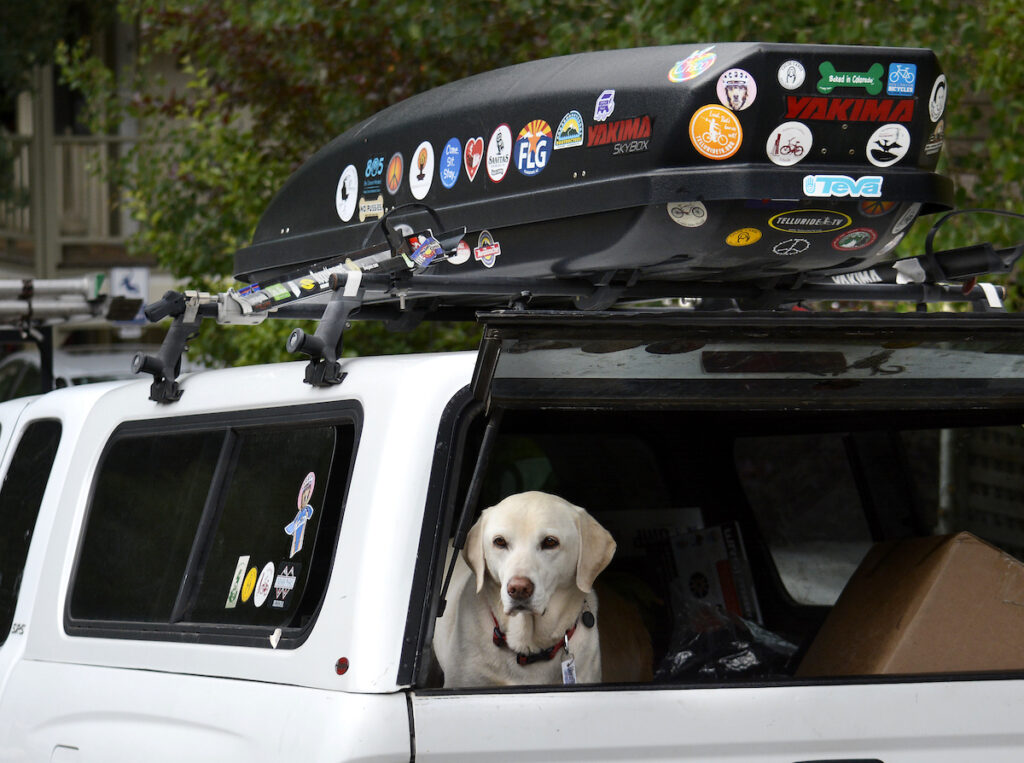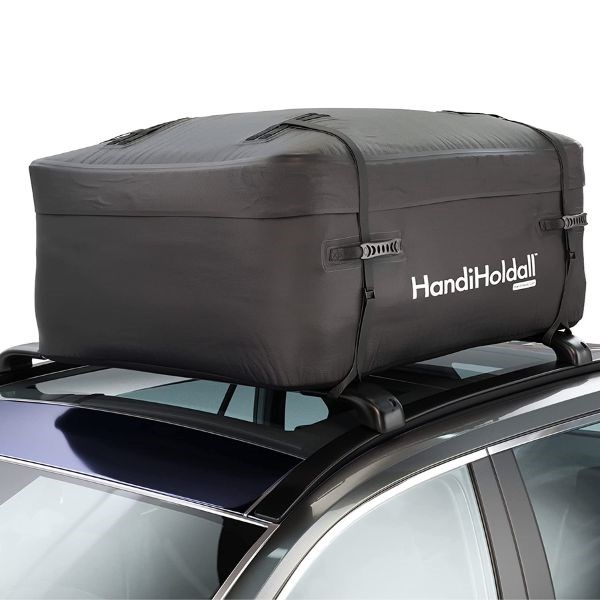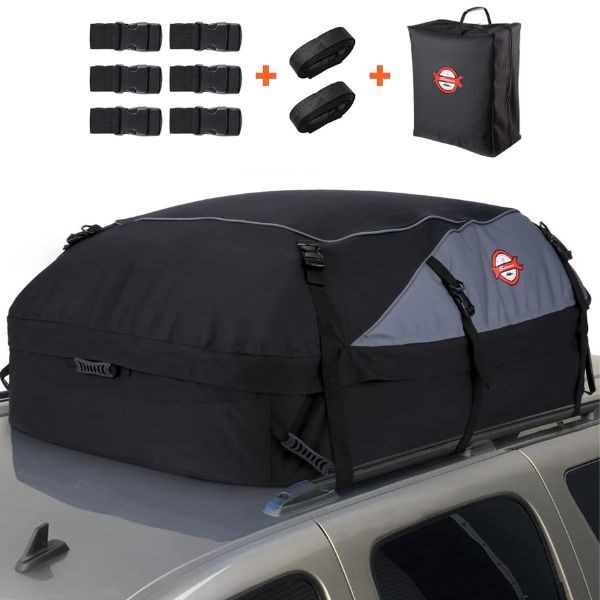Imagine you’re heading out on a road trip, excited to explore new destinations and create lasting memories. But before you set off, you start to contemplate the safety of driving with a roof bag at high speeds. Will it withstand the wind resistance? Is it secure enough to prevent any accidents or damage? In this article, we will address these concerns and provide you with essential information to help you make an informed decision about driving fast with a roof bag.
Factors to Consider
Weight Limitations
When considering driving with a roof bag, one of the most important factors to take into account is the weight limitations of both the roof rack and the vehicle itself. Exceeding the weight limit can lead to severe safety risks, such as roof rack failure or compromised handling of the vehicle. It is crucial to carefully read the manufacturer’s instructions and ensure that the weight of the roof bag and its contents do not exceed the recommended limit.
Aerodynamics
Another crucial factor to consider when driving with a roof bag is aerodynamics. The addition of a roof bag on top of your vehicle can significantly impact its aerodynamic profile. This can result in increased wind resistance, affecting the vehicle’s stability and fuel efficiency. It is important to choose a roof bag that is designed with aerodynamics in mind to minimize these effects.
Secure Attachment
Ensuring a secure attachment of the roof bag to the roof rack is vital for the safety of both your vehicle and other road users. A poorly attached roof bag can pose a serious risk, especially at high speeds. It is essential to carefully follow the manufacturer’s instructions for proper installation and use additional security measures if necessary, such as straps or locks, to prevent any detachment or shifting of the roof bag while driving.
Potential Risks
Increased Wind Resistance
One of the potential risks of driving with a roof bag is the increased wind resistance it creates. The protrusion of the roof bag above the vehicle’s roof can disrupt the airflow, causing drag and reducing the vehicle’s overall aerodynamic performance. This increased wind resistance can result in a decrease in fuel efficiency and make the vehicle more difficult to control, especially in strong crosswinds.
Impaired Handling
The additional weight and altered aerodynamics of a roof bag can also impact the vehicle’s handling. The higher center of gravity created by the roof bag can cause the vehicle to feel less stable, particularly during maneuvers such as turns or lane changes. It is important to drive cautiously and be aware of any changes in the vehicle’s handling characteristics when driving with a roof bag.
Reduced Visibility
Driving with a roof bag can potentially obstruct your view of the road, particularly if it is loaded to its maximum capacity. The bulky nature of the roof bag can limit your ability to see through the rearview mirror or hinder your peripheral vision. It is essential to make necessary adjustments in your driving habits and position your mirrors effectively to compensate for any visibility restrictions caused by the roof bag.

This image is property of www.motorbiscuit.com.
Safety Precautions
Secure Installation
To ensure the safety of both your vehicle and its occupants, it is vital to securely install the roof bag. Carefully follow the manufacturer’s instructions, making sure to attach all straps and buckles tightly. Additionally, periodically check the roof bag during your journey to ensure it remains securely attached. If you notice any signs of loosening or shifting, immediately pull over and rectify the situation before continuing your journey.
Proper Weight Distribution
Maintaining proper weight distribution is crucial when driving with a roof bag. Placing too much weight on one side of the roof or improperly distributing the weight can compromise the vehicle’s stability and handling. Make sure to evenly distribute the weight inside the roof bag and prioritize keeping the center of gravity as low as possible to minimize any adverse effects on vehicle dynamics.
Regular Check-ups
Regularly checking the condition of both the roof bag and the roof rack is essential to ensure optimal safety. Routinely inspect the roof bag for any signs of wear, such as tears or loose seams, and replace it if necessary. Similarly, inspect the roof rack to ensure it remains in good working condition, with no signs of rust or damage that could compromise its strength and ability to hold the roof bag securely.
Effects on Driving Performance
Acceleration and Speed
When driving with a roof bag, it is important to be aware that the added weight and increased wind resistance can negatively impact acceleration and overall speed capabilities. The vehicle may take longer to reach desired speeds and may struggle to maintain high speeds due to the drag caused by the roof bag. Adjust your driving expectations accordingly and avoid aggressive acceleration or driving at excessive speeds to compensate for any limitations.
Braking Distances
The presence of a roof bag can increase the vehicle’s braking distances due to the additional weight and potential shift in the center of gravity. It is essential to allow for increased braking distances to ensure safe and effective stopping in various driving conditions. Practice defensive driving techniques and anticipate potential hazards well in advance to compensate for any potential delays in braking.
Cornering and Maneuverability
Driving with a roof bag can affect the vehicle’s maneuverability, especially during cornering or sudden evasive maneuvers. The higher center of gravity and altered aerodynamics can make the vehicle feel less responsive and potentially lead to compromised stability in such situations. Be cautious when negotiating corners and take extra care when changing lanes or performing sharp turns to compensate for any potential handling differences.

This image is property of asphaltkind.de.
Importance of Speed Limits
Legal Considerations
The adherence to speed limits is not only a legal requirement but also a critical aspect of road safety. When driving with a roof bag, it is important to remain within the prescribed speed limits to ensure optimal control and handling of the vehicle. Violating speed limits not only endangers yourself and other road users but may also increase the risks associated with driving with a roof bag.
Road Safety
Speed limits are established based on numerous factors, including road conditions, traffic patterns, and the general safety of motorists. By driving within the prescribed speed limits, you ensure that you have adequate time to react to potential hazards, maintain a safe distance from other vehicles, and minimize the risks associated with driving with a roof bag.
Risk Assessment
Driving with a roof bag inherently introduces new risks, such as increased wind resistance and compromised handling. By adhering to speed limits, you mitigate these risks to a certain extent and allow yourself more time to identify and respond to potential hazards on the road. It is important to continuously assess the risks associated with your driving circumstances and adjust your speed accordingly to maintain a safe and controlled driving experience.
Type of Roof Bag
Quality and Materials
When choosing a roof bag, it is vital to consider the quality and materials used in its construction. Opt for a roof bag made from durable and weather-resistant materials to ensure it can withstand different driving conditions. A high-quality roof bag will also have reinforced seams and reliable zippers to prevent any water leakage or damage to the contents during transit.
Design and Shape
The design and shape of the roof bag play a significant role in its aerodynamic performance and overall functionality. Look for a roof bag with a streamlined design, as it will minimize wind resistance and improve fuel efficiency. Additionally, consider the shape and size that best suits your needs, ensuring it provides ample storage space while still fitting comfortably on your vehicle’s roof.
Certifications
In order to ensure the safety and quality of the roof bag you choose, it is advisable to look for certifications or endorsements from reputable organizations. Certifications such as ISO (International Organization for Standardization) or TÜV (Technischer Überwachungsverein) indicate that the roof bag has undergone rigorous testing and meets recognized safety standards. Prioritizing certified roof bags ensures that you are making a reliable and safe choice for your vehicle.

This image is property of parkers-images.bauersecure.com.
Quality of Roof Rack
Compatibility and Fit
The compatibility and fit between the roof rack and the roof bag are crucial for both safety and stability. It is important to choose a roof bag that is specifically designed to fit your vehicle’s roof rack system. This ensures a secure attachment and minimizes the risk of the roof bag shifting or detaching during the journey. Confirm the compatibility of the roof bag with your roof rack system before making a purchase.
Weight Capacity
The weight capacity of the roof rack, as specified by the manufacturer, is an important consideration when driving with a roof bag. Exceeding the weight limit of the roof rack can compromise its structural integrity and increase the risks associated with driving. Always verify the weight capacity of your roof rack and ensure that the combined weight of the roof bag and its contents does not exceed this limit.
Sturdiness and Stability
The quality and construction of the roof rack directly affect its sturdiness and stability, which is particularly important when driving with a roof bag. Poorly manufactured or damaged roof racks may not securely hold the roof bag, leading to potential accidents or damage to the vehicle. Regularly inspect and maintain the roof rack to ensure its sturdiness and stability and consult with professionals if any concerns arise.
Emergency Situations
Evading Obstacles
During emergency situations that require evasive maneuvers, driving with a roof bag may pose additional challenges. The altered vehicle dynamics and potential weight shift caused by the roof bag can impact the vehicle’s ability to quickly change lanes or avoid obstacles. It is crucial to practice defensive driving techniques, anticipate potential hazards, and be prepared to make adjustments in your driving strategy when necessary.
Response to Sudden Disturbances
Sudden disturbances on the road, such as potholes or debris, may impact the safety of driving with a roof bag. The additional weight and altered center of gravity can cause the vehicle to respond differently to these disturbances, potentially compromising its stability. It is important to stay alert and be ready to intuitively react to unexpected situations, adjusting your driving as needed to maintain control and avoid accidents.
Adverse Weather Conditions
Driving with a roof bag in adverse weather conditions can significantly impact your vehicle’s performance and safety. It is crucial to consider the potential risks associated with strong winds, heavy rain, or snow-covered roads. The increased wind resistance caused by the roof bag can make your journey more challenging and reduce the overall grip of your tires on wet or icy surfaces, making it even more important to drive cautiously in adverse weather conditions.

This image is property of www.familyroadtrip.co.
Professional Recommendations
Manufacturer Guidelines
Following the manufacturer’s guidelines and recommendations when driving with a roof bag is of paramount importance. The manufacturer understands the specific dynamics and limitations of their product and provides valuable instructions on installation, weight limits, and additional safety precautions. Failing to adhere to the manufacturer’s guidelines may not only compromise your safety but may also void any warranties or guarantees provided with the roof bag.
Expert Opinions
Seeking expert opinions from professionals, such as mechanics or automotive experts, can provide valuable insights into driving with a roof bag. They can offer advice on the compatibility of the roof bag and roof rack, recommend suitable options for your specific vehicle, and provide insights into any potential risks or concerns associated with driving with a roof bag. Their expertise can help ensure a safer and more informed driving experience.
Safety Standards
When considering driving with a roof bag, it is essential to prioritize safety above all else. Pay attention to safety standards and regulations set by relevant authorities. Look for roof bags that meet or exceed recognized safety standards, as this indicates that they have undergone rigorous testing and adhere to specific safety criteria. Prioritizing safety standards ensures that you are making a responsible choice when selecting a roof bag for your vehicle.
Effects on Fuel Efficiency
Increased Drag
Driving with a roof bag introduces additional drag, which can have a significant impact on fuel efficiency. The increased wind resistance caused by the roof bag forces the vehicle’s engine to work harder to maintain a constant speed, leading to increased fuel consumption. To mitigate this effect, choose a roof bag specifically designed to minimize aerodynamic drag and regularly assess your driving habits to optimize fuel efficiency.
Impact on MPG
The presence of a roof bag can reduce the vehicle’s miles per gallon (MPG), as it alters the vehicle’s aerodynamics and increases the overall weight. The exact impact on MPG will depend on various factors such as the size and design of the roof bag, the weight of its contents, and driving conditions. It is important to be mindful of these potential fuel efficiency implications when driving with a roof bag and adjust your expectations and driving habits accordingly.
Driving Habits
Driving habits play a significant role in the overall fuel efficiency when driving with a roof bag. By adopting fuel-efficient driving techniques, such as smooth acceleration, maintaining a consistent speed, and avoiding unnecessary idling, you can optimize the vehicle’s fuel consumption even with the presence of a roof bag. Additionally, pack your roof bag carefully to minimize excess weight and reduce any unnecessary strain on your vehicle’s fuel efficiency.
In conclusion, driving with a roof bag requires careful consideration of various factors to ensure safe and enjoyable journeys. Weight limitations, aerodynamics, and secure attachment are key factors to consider when selecting and installing a roof bag. Potential risks such as increased wind resistance, impaired handling, and reduced visibility should be carefully managed through safety precautions such as secure installation, proper weight distribution, and regular check-ups. Moreover, understanding the effects of driving with a roof bag on driving performance, speed limits, the type of roof bag, and the quality of the roof rack can further enhance safety. It is essential to adhere to speed limits for legal compliance, road safety, and risk assessment. The choice of a high-quality roof bag with suitable design, materials, and certifications, along with a compatible and sturdy roof rack, is crucial for optimal safety and functionality. Emergency situations require additional vigilance, response readiness, and caution due to potential challenges posed by the roof bag. Professional recommendations, including manufacturer guidelines, expert opinions, and safety standards, serve as valuable resources for informed decision-making. Lastly, the impact on fuel efficiency emphasizes the need to consider driving habits and choose a roof bag that minimizes drag and optimizes the vehicle’s MPG. By considering these factors and taking appropriate measures, you can ensure a safe and enjoyable driving experience with a roof bag.

This image is property of parkers-images.bauersecure.com.

